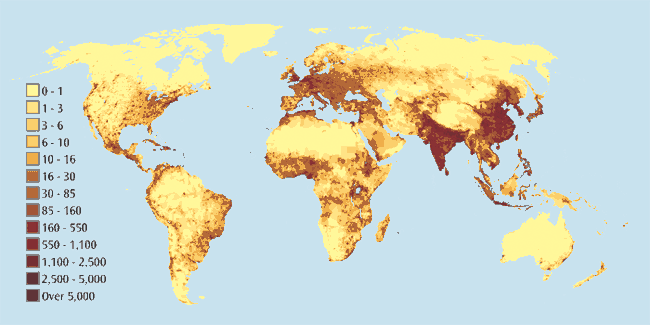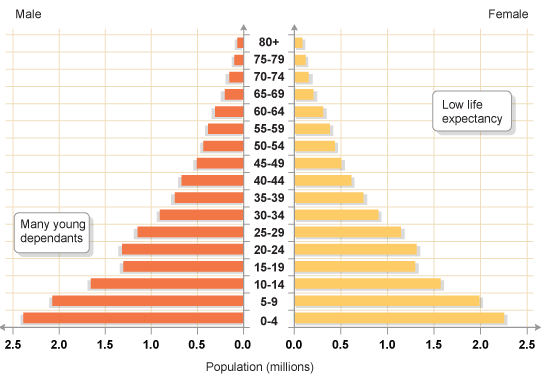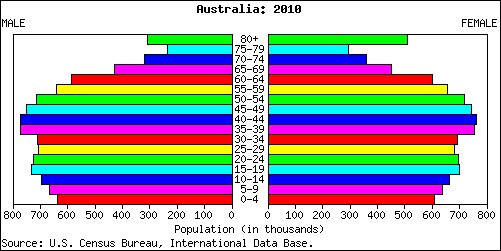
Population
-Christina Garcia-
 |  |  |
|---|---|---|
 |  |
Where is the World's Population Distributed?
Different regions in the world have density clusters and sparse densities in different places. In North America, there are density clusters around Mexico City, the US West Coast, and in the islands of the Caribbean. Places with sparse density in North America are in the Midwest of the US and most of Canada. In Africa, there are population clusters in Ethiopia, Morocco, and Algeria. There is also a big cluster that goes from Guinea to Nigeria. There are sparse densities in Namibia and the northern part Africa. In Asia, the population clusters are in India, the eastern part of China, and parts of Indonesia. There are sparse denisties in Russia, western China, Mongolia, and Kazakhstan. Europe has population clusters in Germany and the United Kingdom. The sparse densities are in Sweden, Finland, and Norway. In South America, the population clusters are at Peru and southeastern Brazil. The sparse densities in South America are at northwestern Brazil, southern Argentina, and southern Chile. Australia and Antarctica also have a sparse density.
There are two types of densities used in population geography. These are arithmetic and physiologic density. Arithmetic density measures the population of a country by dividing the total population and the square miles of land. But it doesn't take in account that some land is more densely populated, so it's not too accurate. Physiologic density is the total population of the area per square mile of arable land. That means that is only uses the size of the land that grows food. For example, in the US, the arithmetic density is 3, but its physiologic density is 160. Another example is that in Mexico, the arithmetic density is 57 and its physiologic density is 405. The measurements are different because not all land is arable. This is why physiologic density is more accurate than arithmetic density.


Physiologic Density
Arithmetic Density
Why is Global Population Increasing?
To measure population growth through the natural increase rate for any country, geographers use the basic demographic equation. The equation is: Future Population = Current Population + Births - Deaths + Immigrants - Emigrants. This equation is true for every country because people are born, die, leave, and arrive everywhere. It makes sense for finding population growth, because it has all the factors needed to find the population. For example, in the US, the current population is 321,796,942. The number of births each year in the US is about 4 million. The number of deaths in the US each year is about 2.6 million. The number of immigrants each year in the US is about 1 million and the number of emigrants each year is 3 million. So the equation for the US would be: Future Population = 321,796,942 + 4,000,000 - 2,600,000 + 1,000,000 - 3,000,000. The future population of the US will be about 321,196,942 people.
You can actually measure births and deaths by using their rates. CBR (crude birth rate) is a measurement of fertility that represents the number of births in a year per 1,000 people. CDR (crude death rate) measures mortality and is represented by the number of deaths in a year per 1,000 people in a population. So for example in the US, the number of births per year is 3,932,181 and the population number is 321,796,942. So the CBR in the US is 12.22. The number of deaths per year in the US is 2,596,993 so the CDR would be 8.07.
A population pyramid is a graphic that shows the number of men and women in a population per range of age. On one side, it shows the number of men of each age group and on the other, it shows the number of women of each age group. You can tell if a population is developing or developed by looking at a population pyramid. Developing nations have lots of young people because they have a high birth rates and developed nations have more of a rectangular shaped pyramid.


Developing Nation: Angola
Developed Nation: Australia
Why Does Population Growth Vary Among Regions?



This is the demographic transition model:
It states that as a country becomes more modern, the death and fertility rates drop. There are four stages in the demographic transition model, but some people argue that there is a fifth stage. The first stage is the most primitive one with high birth and death rates. A group of people in this stage would be the tribes in the Amazon rainforest. The second stage now has low death rates, but still has high birth rates. An example of a place in this stage is Africa. The third stage has a decreasing birth rate and a low death rate. Brazil is an example of a country in this stage. The fourth stage has low birth and death rates, but the birth rates stay higher than the death rates. The US is in the fourth stage.
There are different ways to reduce birth rates. One of them is women's education. It's proven that women that are more educated have less children. This is probably because with an education, they have a better chance of finding a good job they like. Another approach to reducing birth rates is late marriage. If a woman marries someone at an older age, they might not be able to have any children. Going back to good jobs, if a woman has a good education or job going on, they won't want to ruin it by having a partner or kids. So they marry at a late age.
Thomas Malthus was an Englishman who wrote an essay about population. He argued that population growth in the future was going to cause problems with food supplies. He thought this because population grows exponentially. Like for example, it goes from 1 to 2, from 2 to 4, from 4 to 8, etc. But food grows arithmetically; from 1 to 2 to 3 to 4.......
So there might be food shortages in the future if Malthus is correct.
In the demographic transition model, people think there might be a fifth stage to it. If it does exist, it would have a declining death rate and a very low birth rate. Then it would mean that there would be a negative growth rate. A country that might be in the fifth stage is Germany.
Why Do Regions Face Health Threats?
Geographers concern themselves with epidemiology, the study of the causes and spread of disease, because it affects humans. The goal of this is to improve the understanding of the health around the world. They have contributed to research on health in many ways. Lots of the things that geographers study are related to health including the environment, culture, and movement. Environments
sometimes are the causes for diseases like malaria and yellow fever that are caused by tropical environments, good for mosquitos. Culture affects health because some interfere or cause diseases. Like for example, some cultures cause disease like polygyny. Polygyny is the culture practice of a husband having multiple wifes, so this can cause HIV/AIDS. Movement can help diseases by spreading them quicker.
AIDS is a disease that causes the immune system to have a breakdown. It is contracted by sharing body fluids (sexual activity, sharing a needle, etc.) and affects millions of people. This is a worldwide problem because of how it spreads. When someone gets this disease, they don't know that they have it until it's too late. If that infected person gives birth to a child, the child will also get AIDS. AIDS is most common in sub-Saharan Africa where 4.9 million people are infected with the disease. They are affected more because they don't have access to good medical care, drugs, or education programs.
Developed and developing nations differ in health because of poverty and education. Developing nations have less access to medical care because of poverty. Developed nations are richer so they have more advanced technology in medical care. That is one reason why developed nations are healthier. They have access to better medical care. Another factor that make their healths different is education. People in developed nations are more educated about what to do in different types of medical situations. But developing nations are less educated so they have fake remedies like superstitious sayings. They don't know how to react properly when they come to a medical situation. That is why developed and developing nation are different in health.
Developing Nations

Developed Nations
